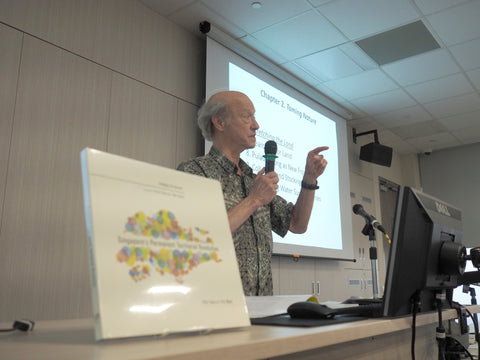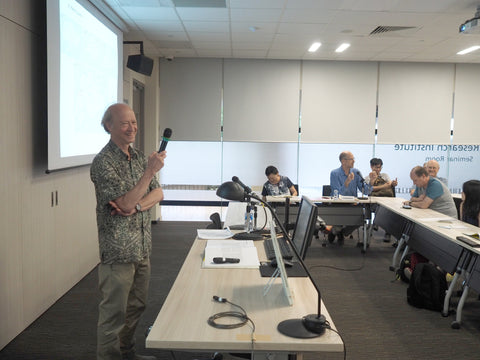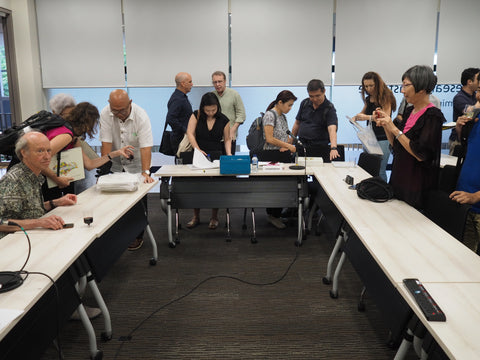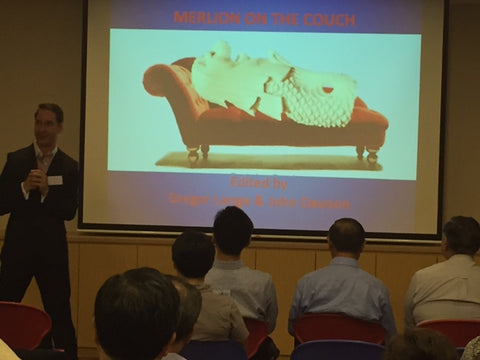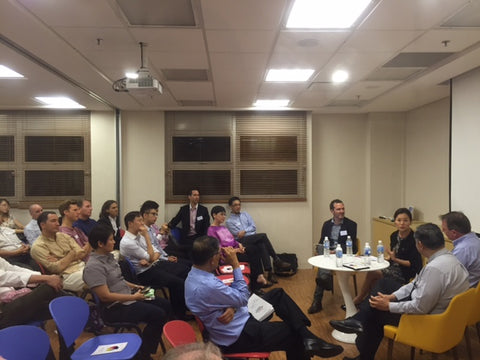News
Follow NUS Press on
Five Minutes with Samuel Ling Wei Chan May 15, 2019 09:42
I n April this year, Dr Samuel Ling Wei Chan published "Aristocracy of Armed Talent, The Military Elite in Singapore". It explores the Singapore Armed Forces by a comprehensive and in-depth examination of its elite leadership: the 170 men (and a very few women) who served or serve as flag officers, that is generals or admirals. How did Singapore build a culture of leadership for its armed forces? What role did the SAF Scholars scheme, introduced in 1971, play in forming this culture?For this edition of Five Minutes With... we turned to noted military expert and journalist David Boey, who conducted this interview and first ran it on his excellent blog on Singapore military matters, Senang Diri. Thanks to David for the interview and for giving us permission to run it on the website.
n April this year, Dr Samuel Ling Wei Chan published "Aristocracy of Armed Talent, The Military Elite in Singapore". It explores the Singapore Armed Forces by a comprehensive and in-depth examination of its elite leadership: the 170 men (and a very few women) who served or serve as flag officers, that is generals or admirals. How did Singapore build a culture of leadership for its armed forces? What role did the SAF Scholars scheme, introduced in 1971, play in forming this culture?For this edition of Five Minutes With... we turned to noted military expert and journalist David Boey, who conducted this interview and first ran it on his excellent blog on Singapore military matters, Senang Diri. Thanks to David for the interview and for giving us permission to run it on the website.
How long did it take you to write the book?
The book is a revised and updated edition of my PhD thesis. I started my studies in March 2011 but by February 2012 it was apparent that my initial topic (on military education in Australia and the US) was not tenable.
What made you press on with research on the SAF despite initial hurdles?
It was a challenge to complete a puzzle and I was focused on the task at hand. The topic is interesting to me, both in academic and general terms.
What was the most challenging aspect of the research for this book?
The most challenging aspects were access to information in terms of open source material and interviews for the specific questions that I had in mind.
How did you go about resolving the challenge(s)?
The 28 interviews were great and a blessing in terms of being able to get the work done.
Which chapter did you enjoy researching/writing most?
I must say I enjoyed them all due to the variation, focus, and information in each of the chapters.
What are the takeaways you hope the reader will glean from the book?
To appreciate the SAF in its entirety, both the good, the quirky, and the not so good.
Who is this Jacques de Coutre the Prime Minister speaks of? January 30, 2019 11:01
From Prime Minister Lee Hsien Loong's speech launching the Singapore Bicentennial: "Around 1630, two centuries before Stamford Raffles, de Coutre proposed to the King of Spain to build a fortress in Singapore, because of its strategic location. Had the King accepted de Coutre’s proposal, Singapore might have become a Spanish colony, instead of a British one."Five Minutes with Andrea Benvenuti June 21, 2017 12:00
 With the recent publication of his new book, Cold War and Decolonisation: Australia’s Policy towards Britain’s End of Empire in Southeast Asia, Andrea Benvenuti seeks to challenge popular views—and misconceptions—of Australian relations with its neighbouring region during the Cold War. Moreover, Benvenuti, a senior lecturer in International Relations and European Studies at the University of New South Wales, offers a fresh and incisive look at the Australian perspective during the emergence of independent Southeast Asian nations and the collapse of British colonial rule.
With the recent publication of his new book, Cold War and Decolonisation: Australia’s Policy towards Britain’s End of Empire in Southeast Asia, Andrea Benvenuti seeks to challenge popular views—and misconceptions—of Australian relations with its neighbouring region during the Cold War. Moreover, Benvenuti, a senior lecturer in International Relations and European Studies at the University of New South Wales, offers a fresh and incisive look at the Australian perspective during the emergence of independent Southeast Asian nations and the collapse of British colonial rule.
In this edition of Five Minutes With …, Dr Benvenuti debunks the myths surrounding Australian political history, particularly those regarding the Menzies government, transplants his Cold War observations into the current political climate, and shares his upcoming projects.
What attracted you to the Australian policy perspective of the Cold War?
One of the enduring myths in Australian political history is that Australia failed to pursue an independent foreign policy in Asia during the early Cold War. As the story goes, under the Liberal–Country Party Coalition government of Sir Robert Menzies (1949–66) Australia overplayed the threat of international communism and became closely aligned with the United States and Britain in an effort to contain the spread of communism in Asia. However, by identifying itself too closely with American and British Cold War policies in Asia, the Menzies government, it is said, foreclosed any chance of engaging meaningfully with its neighbouring region and of developing a distinctive regional role for Australia. The underlying assumption here is that Australia would probably have been better off pursuing a neutralist foreign policy.
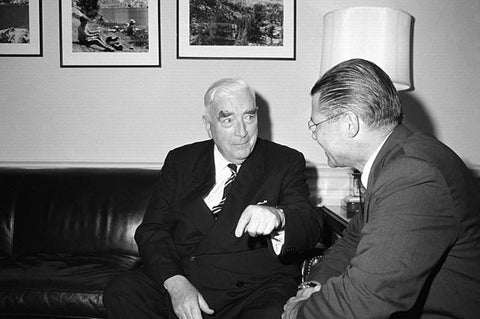
Robert Menzies (left) meets with US Secretary of Defence Robert McNamara at the Pentagon in 1964
(Image credit: Wikimedia Commons).
I have never been persuaded by these kinds of arguments and I thought I ought to find out more. I hope my book will provide a less distorted appreciation of Australia’s Cold War role in Asia and thus make a significant contribution to a better understanding of Australian policy concerns and interests, in a region of paramount strategic, political and economic importance.
What insights does your book offer on Australian foreign policy and relations with Southeast Asia that other historians may have neglected?
Another enduring myth in Australian history and politics is the idea that the Menzies years stand as a blot on the relationship between Australia and Southeast Asia. In Australian universities, scores of undergraduate and postgraduate students are taught to believe that Menzies’ conservative government had little interest in forging close and enduring links with Southeast Asia. According to the prevailing academic wisdom (one that is often embraced with gusto by the Australian media), Menzies’ Anglophilia and his keenness to nurture close ties with Australia’s ‘great and powerful friends’ (the US and Britain) prevented Australia from developing closer regional ties. Only with the arrival of Gough Whitlam at The Lodge (the Australian Prime Minister’s residence in Canberra) in 1972 did Australia begin to seriously engage with the region.
Nothing, of course, could be farther from the truth and my book shows just how grotesque this view is. Under Menzies, Australia pursued a policy of active and sustained regional engagement. Southeast Asia’s political stability and economic prosperity were of utmost importance to Menzies’ Australia, and the Liberal–Country Party government acted accordingly by placing regional engagement at the forefront of its foreign policy.
A clip of Gough Whitlam’s 1974 visit to the Philippines, which was part of a Southeast Asian tour to strengthen ties between the region and Australia. Whitlam also visited Singapore, Malaysia, Thailand, Laos, and Burma. (Source: Whitlam Institute YouTube Channel; footage courtesy of the National Film and Sound Archive and the National Archives of Australia [NAA 4423/31]).
The Menzies government expressed approval of Malaya and Singapore’s bids for merger and independence from British rule. How has this endorsement shaped Australia’s relations with Malaysia and Singapore since the Cold War era?
It has no doubt contributed to drawing Australia closer to Malaysia and Singapore, and forging an enduring and deep relationship with them.
In light of increasing nationalism amongst certain world powers, what lessons on navigating security and international relations from your book might be applicable today?
It is often difficult to compare the world of the 1950s or 1960s with our own. When I talk to my undergraduate students about the early Cold War years in Southeast Asia, I sometimes feel as if I am talking to them about ancient history, given that so much has changed at international and regional levels since then. With this proviso in mind, I venture to offer one possible lesson: as the history of modern Singapore and Malaysia clearly shows, regional political stability and economic prosperity are best maintained through a continuing and robust Western engagement with the region and vice-versa. Beijing’s version of ‘Asia for the Asians’ is really in no one’s interest.
What are your current research projects?
I am currently working on two projects: the first deals with Western (American, British and Australian) responses to the emergence of non-alignment in Asia during the 1950s and early 1960s. The second examines the role and impact of Western military power and strategic foreign policy in the ordering and re-ordering of Asia between 1919 and 1989. It is a collaborative international project sponsored by the Department of History at the National University of Singapore and led by Professor Brian Farrell.
The Challenges of Mapping Singapore’s Permanent Territorial Transformations June 2, 2017 14:30
On May 29, Professor Rodolphe De Koninck launched his latest book, Singapore’s Permanent Territorial Revolution: Fifty Years in Fifty Maps, at the National University of Singapore’s Asia Research Institute. As the third book in a series of Professor De Koninck’s noted atlases—the first was released in 1992, and the second, in 2008—the event saw a huge turnout consisting of local artists, students, heritage advocates, and established local academics.
(Image credit: Sebastian Song)
Professor De Koninck described his early fascination and subsequent research on farmers and vegetable traders in a post-colonial Singapore. He related how his series of atlases was borne out of an unnerving sense of displacement he felt as a returning researcher, having lost his bearings many times in a constantly developing Singapore. In particular, he recalled being struck by the aspirations of his Singaporean friends who, despite having their daily lives dramatically altered by the massive urban transformations of the late 20th century, had taken in all these changes without complaint.
“No other city in the world experiences such rapid and systematic transformations.”
(Image credit: Sebastian Song)
Comparing the urban developments that have unfolded in capitals across the world, Professor De Koninck declared that the territorial evolutions of Singapore are of an unprecedented scale, subsequently proposing the hypotheses at the heart of his book: (1) the resignation of Singaporeans towards socio-economic transformations are in part due to the permanent transformations of the urban landscape, and more importantly, (2) the transient nature of local spaces allows for only a single dimension of territorial allegiance: that of the Singaporean state.
“Nothing is sacred, nothing is permanent, nothing is culturally untouchable.”
(Image credit: Patricia Karunungan)
Bringing the audience into a preliminary view of his book, Professor De Koninck presented the nature of territorial alienation faced by Singaporeans through a vast and fascinating series of maps. These included: the diachronic mapping of changes in the population spread, the distribution of religious places of worship, military training grounds, burial sites and the like. The constant marginalisation, and in some cases, destruction, of culturally sacred spaces, he argued, has precipitated a cultural phenomenon in which “nothing is sacred, nothing is permanent, nothing is culturally untouchable”.
Throughout the talk, Professor De Koninck also debunked several myths—such as that of land scarcity—and raised keen observations surrounding changes in the territoriality and topography of Singapore, such as the non-intentional softening of violent urban transformations in the effervescence of nature alongside roads.
(Image credit: Sebastian Song)
At the end of the talk, Professor De Koninck and members of the audience engaged in a heated Q&A session where they grappled with issues surrounding territory and topography, the alienation of heritage and history from individuals, as well as the politics of identity.
(Image credits: Sebastian Song)
In light of the increasing and galvanising public outcry surrounding the demolition of sites such as Bukit Brown Cemetery, the lessons to be gleaned from Singapore’s Permanent Territorial Revolution, in particular, its comprehensive insights into a Singapore rarely remembered, are now more relevant than ever.
The book is available for purchase in-store at NUS Press and on our online webstore.
Author Events: Ann Wee and Rodolphe De Koninck May 19, 2017 12:00
We’re pleased to announce that two NUS Press authors will be having events in Singapore towards the end of May.
Meet Ann Wee at Kinokuniya (May 27)
Mrs Ann Wee, author of A Tiger Remembers: The Way We Were in Singapore,  will be appearing at Kinokuniya Main Store (Ngee Ann City) on Saturday, May 27 at 4pm.
will be appearing at Kinokuniya Main Store (Ngee Ann City) on Saturday, May 27 at 4pm.
Born in the year of the Tiger, Ann Wee moved to Singapore in 1950 to marry into a Singaporean Chinese family. Affectionately observed and wittily narrated, A Tiger Remembers: The Way We Were in Singapore brings to life Singapore’s social transformation.
A finalist for ‘Best Non-Fiction Title’ for the 2017 Singapore Book Awards, this book captures the things that Ann Wee remembers but history books have left out – questions of hygiene, terms of endearment, the emotional nuance in social relations, rural clan settlements, migrant dormitories, and more.

(Image credit: Ann Wee)
Admission is free—just drop by the Kinokuniya Main Store at 4pm next Saturday!
Talk by Prof Rodolphe De Koninck: The Challenges of Mapping Singapore’s Permanent Territorial Transformations (May 29)
Rodolphe De Koninck will be presenting a talk at the Asia Research Institute at the National University of Singapore on Monday, May 29, 4 – 6.30pm.
Over a period of nearly 25 years, Singapore’s territorial transformations have  been the object of three atlases by Professor De Koninck. The first appeared in 1992, the second in 2008, and Professor De Koninck’s latest book, Singapore’s Permanent Territorial Revolution: Fifty Years in Fifty Maps will be published at the end of the month.
been the object of three atlases by Professor De Koninck. The first appeared in 1992, the second in 2008, and Professor De Koninck’s latest book, Singapore’s Permanent Territorial Revolution: Fifty Years in Fifty Maps will be published at the end of the month.
Ever since Singapore became an independent nation in 1965, its government has been intent on transforming the island’s environment. This has led to a nearly constant overhaul of the landscape, whether still natural or already manmade. No stone is left unturned, literally, and, one could add, nor is a single cultural feature, be it a house, a factory, a road or a cemetery.
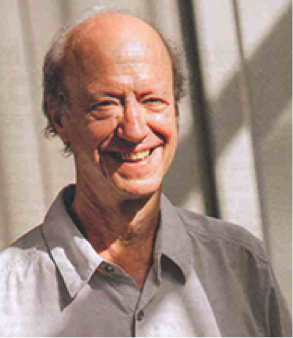
(Image credit: Wilson Pang)
By constantly “replanning” the rules of access to space, Professor De Knoninck shows that the Singaporean State has been redefining territoriality, even in its minute details. This is one reason it has been able to consolidate its control over civil society, peacefully and to an extent rarely known in history.
The talk will be devoted to the presentation of how Singapore’s Permanent Territorial Revolution was produced and, more importantly, to a summary and explanation of its contents and conclusions.
Admission is free but you are encouraged to register your interest with the Asia Research Institute.
World Book Day 2017 April 21, 2017 16:00

The United Nations Educational, Scientific and Cultural Organization (UNESCO), seeks to promote reading, publishing and the protection of copyright through World Book Day, which falls on 23 April every year.
This year, we are celebrating World Book Day by offering a 20% discount on ALL titles on our web store from April 21-23. Use the promo code WBD2017 to enjoy this discount!
Before browsing through our catalogue, here are some fun facts you ought to know about World Book Day:
- April 23 was selected to be the official date for World Book Day in remembrance of the deaths of two major authors: William Shakespeare and Miguel de Cervantes.
- Conakry, Guinea, has been designated World Book Capital 2017, in recognition of its programme to promote reading among youth and underprivileged sections of the population.
- Capital cities in Asia that were previously designated to be World Book Capitals include New Delhi, India (2003), Bangkok, Thailand (2013), and Incheon, South Korea (2015).
- The United Kingdom celebrates World Book Day on March 2 but it celebrates World Book Night on the night of April 23 every year. On World Book Night, books are given out across the UK with a focus on reaching those who do not regularly read across different sectors of society. Books are also gifted through organisations such as prisons, libraries, colleges, hospitals, care homes and homeless shelters.
- Did you know that approximately 6 billion people have access to a mobile phone? UNESCO has shone the spotlight on mobile reading, which has grown exponentially with growing numbers of people reading books and stories on inexpensive mobile phones. In Southeast Asia, NGOs such as Aide et Action have started equipping children in Laos and Cambodia with e-learning devices and e-books to create conducive and communal reading environments.
*****
Happy World Book Day!
Two NUS Press Titles Shortlisted for the 2017 Singapore Book Awards April 7, 2017 10:00
We are pleased that two NUS Press titles have been shortlisted for two categories in this year’s Singapore Book Awards.
Best Non-Fiction Title Finalist
A TIGER REMEMBERS: THE WAY WE WERE IN SINGAPORE
 In A Tiger Remembers, Ann Wee, born in the Year of the Fire Tiger, pays homage to the things history books often deem insignificant — questions of hygiene, terms of endearment, the emotional nuance in social relations, stories of ghost wives and changeling babies, rural clan settlements and migrant dormitories, the things that changed when families moved from squatter settlements into public housing.
In A Tiger Remembers, Ann Wee, born in the Year of the Fire Tiger, pays homage to the things history books often deem insignificant — questions of hygiene, terms of endearment, the emotional nuance in social relations, stories of ghost wives and changeling babies, rural clan settlements and migrant dormitories, the things that changed when families moved from squatter settlements into public housing.
Affectionately observed and wittily narrated, with a deep appreciation of how far Singapore has come, this book brings to life the story of social change through a focus on the institution of the family. The late S. R. Nathan is "certain that this memoir will be absorbed in society and will serve as a conversation piece to learn about the various aspects of our past heritage and culture."
Best Illustrated Non-Fiction Title
CHINESE EPIGRAPHY IN SINGAPORE, 1819-1911
The history of Singapore's Chinese community has been carved in stone and wood throughout the country. Professor Kenneth Dean and Dr Hue Guan Thye's Chinese Epigraphy in Singapore, 1819-1911 looks specifically at 62 Chinese temples, native place associations, clan and guild halls, where epigraphs were made between 1819 to 1911 are still found today. Over the course of four years, Professor Dean and Dr Hue visited more than 400 locations to record, photography, analyse and translate these inscriptions into English. These epigraphs are now faithfully reproduced with more than 1,300 illustrations in these two volumes.
The Singapore Book Awards is an industry award for books published in Singapore. Into its third edition, the awards shine the spotlight on the quality of published works and celebrate the achievements of the local publishing industry.
This year’s award winners will be announced at an Awards Ceremony at Pan Pacific Singapore on April 20, 2017. For more information about the Singapore Book Awards and other award categories, click here.
Five Minutes with Ronald McCrum February 24, 2017 10:00
This year marks the 75th anniversary of the Fall of Singapore. Considered one of the greatest defeats in the history of the British Army during World War Two, retired British Army Officer and military historian, Ronald McCrum, undertakes a close examination of the role and the responsibilities of the colonial authorities in his new book, The Men Who Lost Singapore, 1938-1942.
Considered one of the greatest defeats in the history of the British Army during World War Two, retired British Army Officer and military historian, Ronald McCrum, undertakes a close examination of the role and the responsibilities of the colonial authorities in his new book, The Men Who Lost Singapore, 1938-1942.
In this edition of Five Minutes With ..., we talk to Colonel McCrum to get his insights on how his military background helped his research, his history and ties with Southeast Asia, and whether co-ordination between civil authorities and military bodies has improved nearly eight decades on.
How did you come to be interested in the military history of this particular region?
My interest in military history was, I suppose, inevitable. At 18 years of age, I decided to become a soldier and at Sandhurst, the officer training college, part of the curriculum is military history and it fascinated me. In any case, it was now my chosen profession and I almost felt duty bound to understand something of the trials and tribulations of my predecessors.
The Far East, Malaya/Malaysia and Singapore were of particular interest because I spent a lot of my life in these parts. I first came to the area not long after the end of the war (1948/49?)—my father was then stationed in Nee Soon. We lived just outside Johor Bahru and I went to ‘English College’ in Johor Bahru. After a period in England, we returned to Malaya, this time to Kuala Lumpur (KL) and I went to Victoria Institution in KL. So the formative years of my life were in this part of the world.

McCrum in Germany (Iserlohn), 1981
(Image credit: Ronald McCrum)
In your book you discuss the various factors leading up to Singapore’s downfall, particularly how the preparation and execution of British defence strategies were addled by the conflicting views, interests and priorities of the military and civil authorities. In what ways has your military experience allowed you to be more attuned to these issues?
In 1965, after I had been a commissioned officer in the British Army for a number of years, an opportunity arose to be seconded for a period to the Malaysia Armed Forces and I accepted. I was sent to the Malaysian Military College at Sungei Besi just outside KL as an instructor. While in Malaysia my first two sons were born, the first shortly after we arrived and the second just before we returned to UK. And then surprisingly in 1970 after completing a year’s course at the British senior officers Staff College I was sent to Singapore as the Assistant Defence Advisor to the British High Commissioner. Where I spent two and half very happy years and my third and last son was born there. All three boys have Southeast Asia in their blood.
You’ve pointed out the civil authorities were slow to recognise the impending threat of the Japanese invasion. Was this general across other European colonies in Southeast Asia, or was it particular to Singapore? Do you think issues of co-ordination between civil authorities and military bodies improved with the advent of new technologies and procedures of co-ordination today?
While in Malaysia/Singapore I was endlessly curious about how the British Forces were so easily beaten in 1941/42. And in my travels I took the chance to visit the scenes of the battles that took place. After much reading, I began to recognise that in those early days of a new form of mobile modern warfare no one escaped an enveloping invasion. Inclusive lessons of total war were quickly learnt in the West, but in the quiet backwater of South East Asia such a prospect seemed remote. Glaringly obvious afterwards was the need for a combined (civil and military) planning headquarters, with an overall supremo able to impose decisions. At that time the three military services had each their own HQ’s in different locations in Singapore and the Governor was remote in Government House. Now of course a combined planning authority is normal greatly helped, of course, by modern communications. I cannot think of a current example where the civil and military authorities do not work closely together towards a common aim. A good instance in the Far East, after the war, was the combined operations of all the authorities in Malaya planning the defeat of the communist terrorists during the Malayan Emergency.

McCrum in Israel, 1988
(Image credit: Ronald McCrum)
What also struck me as grossly negligent was the poor, indeed almost non-existent, liaison between the Colonial Office and the War Office in London. One was demanding increased production of tin and rubber and the other telling the military they had to employ local labour to prepare defences. The same labour that was required on the rubber estates and the tin mines. There were of course a number of other very important factors that played a crucial part in the defeat, but the authorities quarrelling on basic matters like this did not help.
What are your future plans? Are you thinking of writing another book?
I am well into researching another book. This time a biography of a significant British figure who played an important part during the Indian Mutiny of 1857.

McCrum in Singapore with an advance copy of
The Men Who Lost Singapore in early February 2017
(Image credit: Pallavi Narayan)
#BuySingLit Highlights (Part 3) February 23, 2017 14:30
In the third installment of our series on #BuySingLit highlights, we look at memoirs written by Singapore authors. Through the memoirs published here at NUS Press, the experiences and personal anecdotes shared by authors have allowed readers to learn more about their outlook on life and the world around them.
Here is a short reading list that gives you glimpses of Singapore and the wider world through different lives that have been lived.
|
From the Blue Windows: Recollections of Life in Queenstown, Singapore, in the 1960s and 1970s
By Tan Kok Yang Have you ever wondered what everyday life was like in one of the earliest housing estates in Singapore during the 1960s and 1970s? In From the Blue Windows, Tan Kok Yang reminisces about life during his formative years in Queenstown. Coupled with a sense of nostalgia, Tan’s memoir pays tribute to the estate he grew up in and takes readers back to a simpler time of Singapore’s bygone past. |

|
|
A Tiger Remembers: The Way We Were in Singapore Born in the Year of the Fire Tiger, Ann Wee arrived in Singapore in 1950 to marry into a Singaporean Chinese family. Affectionately observed and wittily narrated, A Tiger Remembers recounts her experiences of cross-cultural learning such as domestic rituals and emotional nuances in social relations, along with various untold stories of Singapore’s past. With a strong appreciation for Singapore’s social transformation, this book provides a frank perspective on the shapes and forms of the Singapore family through the eyes of a keen social observer. |
 |
|
Tall Tales and MisAdventures of a Young Westernized Oriental Gentleman What transpires when a young Asian student finds himself in the Ireland of the 1950s? This memoir by Singaporean novelist Goh Poh Seng details his adventures as a student in a world with an entirely different milieu and culture. Through his travels in Europe and stay in Dublin, readers are able to catch a glimpse of what shaped Goh to become the writer he is known as today. |
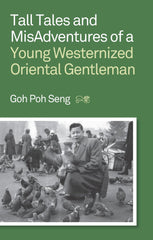 |
#BuySingLit Highlights (Part 2) February 22, 2017 10:00
In part 2 of our series on #BuySingLit highlights, we shift our attention to the discipline of Sociology. In the words of C Wright Mills, “neither the life of an individual nor the history of a society can be understood without understanding both”. Within the local context, Singapore society provides compelling subject matters for sociological inquiry given its metamorphosis since independence.
Here are two NUS Press titles that offer in-depth perspectives of specific social phenomena in Singapore.
|
Remembering the Samsui Women: Migration and Social Memory in Singapore and China
By Kelvin E.Y. Low Leaving their families behind and migrating from the Samsui region of Guangdong, China for a better life abroad, how did the Samsui women come to be icons of Singapore’s burgeoning economic transformation? How were these women, who donned the iconic “red head scarf” (红头巾), remembered for their hard work and sacrifices both in Singapore and China? Situated in the politics of social memory and the processes of remembering and forgetting, Kelvin Low explores first hand accounts of the women’s migratory experiences and how they were ultimately reinvented as industrious pioneers of Singapore through the memory appropriation of the Samsui women. |
 |
|
The AWARE Saga: Civil Society and Public Morality in Singapore After the Association of Women for Action and Research (AWARE) was helmed shortly by a Christian faction in March 2009, the controversy foregrounded issues such as religion, sex education, homosexuality, and state intervention within Singapore’s civil society. In this book, academics and public intellectuals situate the AWARE saga within the country’s political and historical context, further discussing the role of religion in Singapore’s civic society. |
 |
#BuySingLit Highlights (Part 1) February 21, 2017 10:00
NUS Press is proud to take part in the #BuySingLit campaign, the first nationwide initiative led by the local publishing industry to promote the reading and purchasing of Singapore literature. In addition to discounts on selected titles available on our web store, we are also highlighting literary and non-fiction titles in a series of blog posts throughout the week.
Our first installment showcases the Press’s literary publications.
|
The Collected Poems of Arthur Yap By Arthur Yap, with an introduction by Irving Goh Sometimes referred to as a “poet’s poet,” Arthur Yap (1943–2006) published four major collections between 1971 and 1986, all of which are now out-of-print. With color reproductions of original cover art, many of which are Yap’s own paintings, and a critical introduction by Irving Goh, this volume of collected poems represents the burgeoning of recent scholarly activity surrounding his oeuvre. |
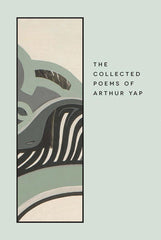 |
|
Noon at Five O’Clock: The Collected Short Stories of Arthur Yap For the first time ever, the rarely-seen short stories of Arthur Yap are brought together in a single volume of collected work. These short stories are less sprawling tales than miniature vignettes—or what Shirley Geok-lin Lim calls “his little area of animation”—all of which proffer glimpses into a mind constantly grappling with the aesthetics of global modernism with the lived experiences of modernity in a newly independent Singapore. |
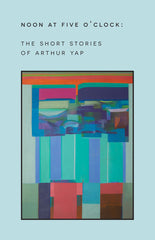 |
|
If We Dream Too Long Widely regarded as the first Singapore novel, If We Dream Too Long explores the dilemmas and challenges faced by its hero, Kwang Meng, as he navigates the difficult transitional period between youthful aspirations and the external demands of society and family. Since its first publication in 1972, Goh's novel has moved and delighted generations of readers and was most recently given a new lease of life and adapted into an interactive theatre-dinner production by Marc Nair and AndSoForth in May 2016. |
 |
|
Writing Singapore: An Historical Anthology of Singapore Literature This volume, which chronologically surveys literary work from the nineteenth to the twenty-first century, broadens the idea of a national literature with its inclusion of stories and poems from the Malay Annals and the Straits Chinese Magazine, as well as classic and forgotten work by Lee Kok Liang and Kassim Ahmad. With its rich offerings of primary material and criticism, Writing Singapore is an excellent resource for anyone with an interest in Singapore literature. |
 |
NUS Press Highlights of 2016 December 27, 2016 10:30
While 2016 has proven to be a rather bleak and tumultuous year, we are proud to have published some books that will continue to have much bearing in the new year ahead.
ENVIRONMENT
All eyes will continue to be on Indonesia’s Peatland Restoration Agency as it implements plans of restoring peatland to prevent haze crises (like that of 2015) from engulfing the region again.
Two NUS Press books, Catastrophe and Regeneration in Indonesia’s Peatlands (edited by Kosuke Mizuno, Motoko S. Fujita and Shuichi Kawai) and The Oil Palm Complex (edited by Rob Cramb and John McCarthy) touched on some agricultural and labour challenges that Malaysia and Indonesia are facing within the oil palm industry and peatland agriculture. In his review of both books in The Jakarta Post, James Erbaugh commented that both titles “provide scholarship that elucidates the complexities of oil palm production, and the challenges presented by peatland agriculture as well as peatland restoration.”


POLITICS
Indonesia’s gubernatorial election is set to take place in February 2017 and Edward Aspinall’s and Mada Sukmajati’s edited volume, Electoral Dynamics in Indonesia will be handy for observers as it provides greater insight into the patronage systems and money politics at the grassroots level.

In the field of maritime developments: Tensions in the South China Sea will continue to have much bearing on US-China and China-ASEAN relations in 2017. Ng Chin-keong’s collection of essays, Boundaries and Beyond, provides a novel way of understanding the nature of maritime China, and the undercurrent of social and economic forces that have created new boundaries between China and the rest of the world.
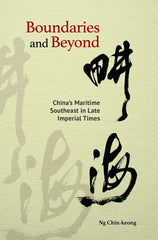
Lastly, in light of the 29th Southeast Asian Games taking place in Kuala Lumpur next year, Stephen Huebner’s Pan-Asian Sports and the Emergence of Modern Asia, 1913-1974 explores the role international sporting competitions had in shaping discourses of nationalism and development across Asian states. As one of the first major studies of the history of sports in Asia, Dr Huebner’s book provides a compelling window into the intersection between sports and politics in the region.

SINGAPORE HISTORY
The history of pre-independence Singapore remained a staple to our publishing programme this year, with Timothy Barnard’s Nature’s Colony shedding much light on the Singapore Botanic Gardens' lively history. Professor Barnard examined the Gardens’ changing role in a developing Singapore—from colonial times under the charge of several colourful Superintendents and Directors, to today, as a World Heritage Site.

On a more personal level, social work pioneer Ann Wee reminisces about her eventful life in Singapore. Her memoir A Tiger Remembers ruminates on the Singaporean family, and presents the reader with a series of charming vignettes from her life that captures the nuanced transformation of Singaporean society over the years. These intimate recollections, all told in exquisite detail and rich with insight, are testament to the vibrant cultural heritage of the nation.

We are also proud to have published Professor Kenneth Dean and Dr Hue Guan Thye's two-volume set, Chinese Epigraphy in Singapore, 1819-1911, which has been described by Claudine Salmon, Director of Research Emeritus at the French National Centre for Scientific Research (CNRS), Paris to be a "a repository of Singapore cultural and historical heritage." The collation of over 1,300 epigraphic records is a breakthrough in the telling of the Singapore story and according to Prof Dean, "such inscriptions provide snippets of what life was like in 19th and early 20th century Singapore, and capture the diverse cross-section of society at that time."

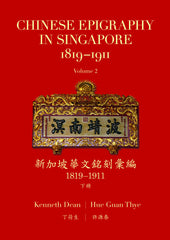
SOUTHEAST ASIAN ART HISTORY
What importance does art hold in the representation of history?
In the context of the portrayal of Southeast Asia by its colonial masters, Sarah Tiffin’s Southeast Asia in Ruins explores how the British justified colonialism through imperial art. Dr Tiffin will be speaking at the National Gallery Singapore on 25 February 2017 about British artists' portrayal of Southeast Asian civilization(s) in ruins in Stamford Raffles' The History of Java, and the role that these artists (and their work) played in Britain’s imperial ambitions in Southeast Asia.

In 2017, photographers and photojournalists will continue to play a vital role in exposing the realities of an increasingly authoritarian Southeast Asia. Zhuang Wubin’s Photography in Southeast Asia will be a useful introduction to the discourse of photographic practices in the region as his survey provides insights into the role images play in shaping Southeast Asian society, culture and politics.
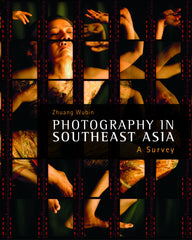
Five Minutes with Brian Bernards November 22, 2016 15:00
In this special edition of our author-interview series, Professor Philip Holden from the National University of Singapore conducted an email interview with Professor Brian Bernards on the occasion of the publication of the Southeast Asian edition of Writing the South Seas: Imagining the Nanyang in Chinese and Southeast Asian Postcolonial Literature. An assistant professor at the University of Southern California, Bernards works in three languages – English, Chinese, and Thai—and his book thus gives a revisionary perspective on the literatures of the region, and indeed the way in which we imagine Southeast Asia itself.
University of Singapore conducted an email interview with Professor Brian Bernards on the occasion of the publication of the Southeast Asian edition of Writing the South Seas: Imagining the Nanyang in Chinese and Southeast Asian Postcolonial Literature. An assistant professor at the University of Southern California, Bernards works in three languages – English, Chinese, and Thai—and his book thus gives a revisionary perspective on the literatures of the region, and indeed the way in which we imagine Southeast Asia itself.
Professor Holden's and Professor Bernards' exchange was first published on singaporepoetry.com. We are pleased to present some excerpts of their lively discussions:
Philip Holden: As someone who has been studying auto/biography, I’m always interested in the life stories of scholars. What drew you to study Chinese and Thai? And what fostered your interest in the literatures of Southeast Asia?
Brian Bernards: When I was 9 years old, a family from Shanghai (a father, mother, and their 2-year-old daughter) moved in with my family at our home in Minneapolis. The father was studying engineering at the University of Minnesota, and the mother, who later went on to study accounting, became our live-in babysitter. On occasion, our two families had meals together, and the boiled dumplings (shui jiao) our sitter cooked became quickly my new favorite dish. Our good friends from Shanghai lived with us for about two years, when the father graduated and found a plush job in Milwaukee. Starting high school about three years later in 1992, I opted to take Mandarin because of my prior exposure to Chinese culture (and cuisine!). I first traveled to mainland China in 1998, where I studied for a year at Sichuan University in Chengdu. My language professor recommended Chengdu because she had done research there, she knew I wanted to tread beyond the typical path of studying in Beijing, Shanghai, or Taipei, and, most importantly, she knew I would like the spicy ma-la food there. Living and attending school in Chengdu certainly opened my eyes, and my taste buds, to new experiences, flavors, and possibilities.
PH: Given your exposure to different disciplines, what are your thoughts on inter-disciplinary studies?
BB: I have always enjoyed literature (especially fiction and poetry), music, and film. As a student and traveler, I felt I could better connect with a place, a culture, a society, and its history through the very personal stories and creative imagination conveyed in fiction and memoirs by authors who were from or who were very familiar with that society. While Southeast Asian studies in the US is largely a social science-oriented field, I was fortunate to take history and anthropology classes as an undergraduate from professors who, rather than assigning dry textbook readings, assigned novels by authors such as Pramoedya Ananta Toer, José Rizal, Duong Thu Huong, Ma Ma Lay, and Kukrit Pramoj, to be read in conjunction with course lectures. I was very inspired by this approach to history and cultural studies, not only because it put the human impact of historical events and social transformations in relatable narratives rather than abstract figures, but also because the micro-histories we encountered in such literary narratives often challenged or even contradicted the standard interpretations and “big picture” perspectives taken for granted in the official histories. I am grateful to my teachers for cultivating the approach that would stick with me as I moved forward into graduate studies.
PH: What was the process of writing Writing the South Seas like?
BB: Writing the South Seas began as a way of combining my interests and background knowledge in modern Chinese literature, Southeast Asian studies, and postcolonial literary theory in an attempt to make a novel contribution, and hopefully a type of critical intervention, in each field. I felt the varying approaches from these different fields could be mutually illuminating in ways that the disciplines had yet to sufficiently consider. Mainly, I sought to bring a Southeast Asia-centered perspective to the study of literatures in Chinese on and from the region. Luckily, I conceived the project at the time that Sinophone studies was emerging and bringing about a sea-change in the modern Chinese literary field. Sinophone studies not only emphasizes cultural networks across national and ethnic boundaries, but also seeks to situate such networks locally in their multilingual milieu. In this sense, my interests in Anglophone literature and Thai-language literature from Southeast Asia, which might have otherwise been seen as irrelevant or marginal to modern Chinese literary studies, could provide an insightful comparative perspective that showcased the cross-lingual interactions and relationships of these Sinophone literary networks. I owe a significant intellectual debt to the pioneering work of Shih Shu-mei in this regard.
PH: The cover of your book will have a particular resonance for many Malaysians and Singaporeans. Could you explain this?
BB: I really have you to thank for this, Prof Holden, as you were the first person to recommend Suchen Christine Lim’s novel Fistful of Colours to me when I began researching Anglophone authors in Singapore. As you know, at the end of the novel, the protagonist returns to Kuala Jelai, her home village in Malaysia, from Singapore, and she becomes moved viewing the large wall murals while waiting for her train at the Tanjong Pagar Railway Station. When I read this passage, I wanted to see the murals myself, though at the time I had no idea they would later provide the source material for the cover of my book.
That was before the station closed. When it was operational, the station, along with the Keretapi Tanah Melayu (KTM) railway tracks, was an important living legacy of the intimate relationship, common colonial history, and shared culture between the two countries. Now that it is closed, it can only serve as a “heritage site” – a relic or a reminder of that past. For a lot of Malaysians and Singaporeans who grew up when the two societies were more integrated, Tanjong Pagar is bound to be a source of nostalgia, especially because it conjures a more rustic landscape and older colonial architecture that contrasts with the image of Singapore as a city of glistening skyscrapers and squeaky-clean air-conditioned malls. I think this nostalgic sentiment regarding the railway station is quite obvious in “Parting,” director Boo Junfeng’s contribution to the omnibus film, 7 Letters: he uses the space of Tanjong Pagar to tell the story of an interethnic romance against the backdrop of racial riots in the 1960s.

Interior of Tanjong Pagar Railway Station, 2010
(Image credit: Jacklee, Wikimedia Commons)
Of the six triptych murals in the station, the one with the commercial maritime focus showing the harbour was the most relevant to my book in its entirety, so I commissioned an image of that mural for the cover. The different types of ocean vessels in the image, from a sampan to a junk to a passenger steamship, really captured the varying modes of maritime crossings and convergences that the Nanyang has historically signified. And it’s beautifully done.
****
NUS Press would like to thank singaporepoetry.com's founding editor, Koh Jee Leong for granting permission to republish these excerpts.
Sayonara, 2016 Singapore Writers Festival November 18, 2016 17:00
With Japan as its country focus, the 19th Singapore Writers Festival came to an end last weekend after ten action-packed days of literary talks, discussions, music, and performances.
NUS Press was proud to have been one of five publishers featured in The Paper Trail, a backroom tour of Singapore publishers led by poet Yong Shu Hoong on November 5. Our director Peter Schoppert addressed a group of about 30 people and gave a quick overview of the history of the university press, and how it came to establish a foothold in the academic publishing scene in Asia.

(Image credit: Caroline Wan, National Arts Council)
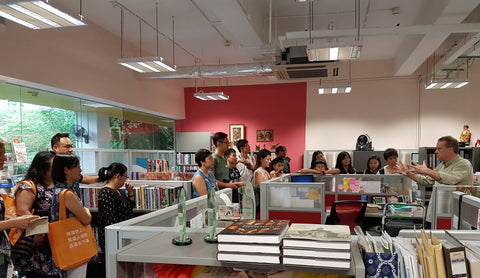
(Image credit: Yong Shu Hoong)
Author Yap’s poems and short stories, and Goh Poh Seng’s memoir and novel, If We Dream Too Long, were naturally snapped up by some tour participants.

(Image credit: Caroline Wan, National Arts Council)
On November 6, two of our authors, Lim Cheng Tju, co-author of The University Socialist Club and the Contest for Malaya: Tangled Strands of Modernity, and Mrs Ann Wee, author of A Tiger Remembers: The Way We Were in Singapore, appeared on a panel alongside Nilanjana Sengupta at the Asian Civilisations Museum to share how everyday experiences, lesser-known stories, and oral histories are crucial for a better understanding of Singapore's past.
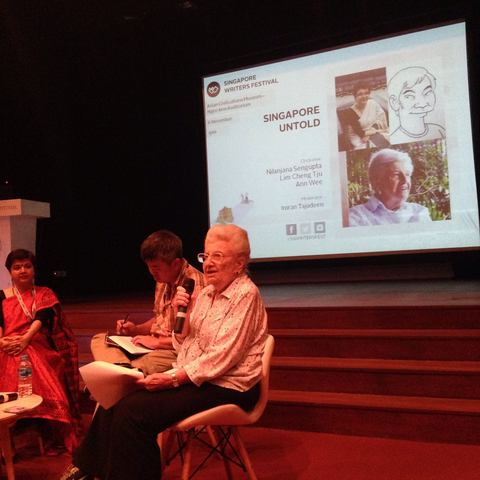
(From left to right) Nilanjana Sengupta, Lim Cheng Tju and Ann Wee
(Image credit: Chye Shu Wen).
Last but not least, we caught the matinee performance of The Finger Players’ love-letter to Singapore’s literary history, Between the Lines: Rant and Rave II. It was a delight to watch Serene Chen and Jean Ng act out key literary milestones in the development of Singapore’s cultural landscape. We were thrilled to have had some of our publications and authors (Edwin Thumboo, Arthur Yap and Goh Poh Seng to name just a few) featured in this play.

(Image credit: Chye Shu Wen)
At the end of the play, the stage became a pop-up shop for 30 minutes and it was heartening to see audience members stream down to the stage to browse through and purchase the books that were featured in the play.
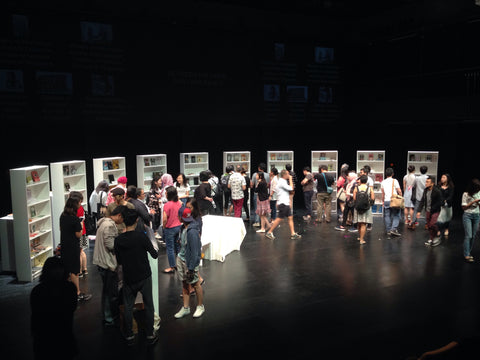
(Image credit: Chye Shu Wen)
We look forward to the 20th edition of the Singapore Writers Festival, which is set to take place from 2–13 November 2017.

NUS Press at the 2016 Singapore Writers Festival November 4, 2016 11:00
NUS Press is pleased to be participating in this year's Singapore Writers Festival (SWF)! Themed "Sayang," the festival will feature close to 320 writers, speakers and performers between November 4–13.
To celebrate, we are offering special prices for this selection of titles!
We will also be featured in these main events:
Singapore Untold | 6 Nov, 1–2pm |
Asian Civilisations Museum (Ngee Ann Auditorium)
Our authors, Ann Wee, a pioneer of social work education in Singapore and author of A Tiger Remembers: The Way We Were in Singapore, and Lim Cheng Tju, co-author of The University Socialist Club and the Contest for Malaya: Tangled Strands of Modernity, will be appear in this panel alongside Nilanjana Sengupta to discuss why they have written stories that are often not found in Singapore history textbooks. They will also talk about their experience of uncovering and writing these stories.
You can attend this event with a SWF Festival Pass (S$20), which is available via SISTIC.
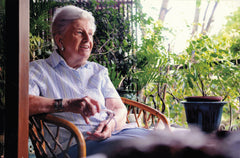

Ann Wee (left) and Lim Cheng Tju (right) (Image sources: Singapore Writers Festival).
Between the Lines: Rant & Rave II | 4–6 Nov, various times |
School of the Arts (SOTA) Studio Theatre
Simultaneously a crash course in, and a love letter to SingLit, Between The Lines: Rant & Rave II will take you on an odyssey of the evolution of the English-language literature scene in Singapore through the decades. Actors Serene Chen and Jean Ng as they take on the roles of real-life poets, novelists, publishers and many more in this loving tribute to the written word.
NUS Press is pleased that a number of books and authors we have published (from Edwin Thumboo's 1973 book, Seven Poets: Singapore and Malaysia, to Arthur Yap's Collected Poems) will be featured in this performance!
Between the Lines was commissioned by SWF and is presented by The Finger Players. Tickets (S$35) are available via SISTIC.
Serene Chen and Jean Ng rehearsing for "Between the Lines" (Image courtesy of The National Arts Council).
The Paper Trail: A Backroom Tour of Singapore Publishers (SOLD OUT) |
5 Nov, 9am–1pm | Various locations
Launch of "Nature's Colony" at the Singapore Botanic Gardens October 21, 2016 11:00
Timothy Barnard launched his latest book, Nature’s Colony: Empire, Nation and Environment in the Singapore Botanic Gardens, at the Singapore Botanic Gardens on October 14, as part of the Gardens' regular speaker series.


(Photos courtesy of Sebastian Song)
Professor Barnard centred his talk around the history of the Gardens and its broader impact beyond its bounadries in environmental, political, and
social terms.


(Photos courtesy of Sebastian Song)
Professor Barnard explained that the botanic gardens was established as a private park between 1869 and 1874. By the early 1870s, the British realised that it had the potential of becoming a key colonial institution because imperial botany was seen as a tool that could strengthen empire (i.e. rubber seeds could be harvested in Singapore and Malaya, which could then be traded as a commodity).
The ever-changing position of the Singapore Botanic Gardens in society and politics over time has also often been overlooked: Professor Barnard emphasised the Gardens' precarious position as a colonial institution in a decolonialising society in a post-Merdeka era.
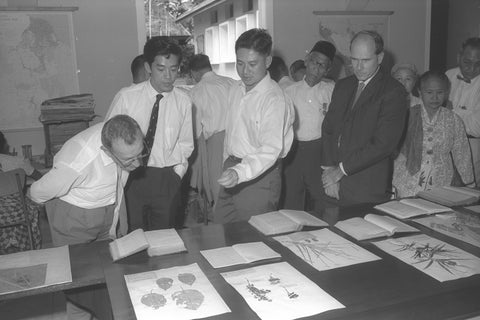
Humphrey Burkill, Director of the Singapore Botanic Gardens from 1957 to 1969, leading a tour of government officials at the opening of the “renovated” herbarium in October 1964 (Source: Ministry of Information and Arts Collection, courtesy of the National Archives of Singapore).
One of the highights of the talk was a segment on Henry Ridley, the Director of the Singapore Botanic Gardens between 1888 and 1912. Ridley was seen as “mad” by many of his contemporaries within the colonial government in Singapore due to his quirks and views of how the Singapore Botanic Gardens should be developed.
Ridley accomplished a lot during his tenure as director—from overseeing the set up of a short-lived zoo (1875-1905), to the establishing an Economic Garden within the park. Ridley also had the foresight to see that planting oil palm would have economic advantages for the region.

Henry Ridley with a small panther (Image reproduced with the kind permission of the Board of Trustees of the Royal Botanic Gardens, Kew).
The talk was followed by a lively question and answer session that was moderated by the Group Director of the Singapore Botanic Gardens, Dr Nigel Taylor.

(Photo courtesy of Sebastian Song)
At the end of the talk, many queued up patiently for Barnard to sign their copies of Nature’s Colony.



(Photos courtesy of Sebastian Song)
We would like to thank the Singapore Botanic Gardens for hosting the launch. If you would like to hear snippets of what Barnard said that day, you can check out his interview with talkshow host, Michelle Martin, on 93.8 Live’s Culture Café here, where he discussed his book and the history of the Gardens.
Launch of "Photography in Southeast Asia" in Singapore October 18, 2016 17:00
Zhuang Wubin's Photography in Southeast Asia: A Survey was launched at Objectifs Centre for Photography and Film on October 13, 2016. The launch featured a dialogue between Zhuang and famed street photographer, Chia Aik Beng, followed by a lively question and answer session.

(Photo courtesy of Kevin Lee)
Zhuang and Chia discussed the influence and impact social media has had on photography. When asked by Zhuang about the advantages and disadvantages of using Instagram as a platform for showcasing work, Chia said, "Instagram is a social media platform; it is not a photo gallery or website. If I'm on a project, I will share some images [on my Instagram account], to tease people and then direct them to my website. This is how I distribute information."





For a detailed transcript of what was discussed during the book launch, you can read Invisible Photographer Asia's coverage of it here. We are grateful to Objectifs for sponsoring the venue for this book launch, and to Kevin Lee for being the official photographer of the event.
NUS Press Book Launches in October 2016 October 7, 2016 15:00
October is looking up to be a very busy but exciting month for us with three book launches taking place in Singapore!
|
BOOK LAUNCH & DIALOGUE
|
|
AUTHOR TALK & BOOK LAUNCH
|
|
BOOK LAUNCH
|
The Countdown to the 2016 Singapore Writers Festival has Begun! September 9, 2016 12:14
On September 6, members of the press and Singapore’s publishing scene gathered at Bhaskar’s Arts Academy for a media conference, where Singapore Writers Festival (SWF) director, Yeow Kai Chai, unveiled a solid line-up of writers and events for this year's festival.
Themed “Sayang,” the 19th edition of the festival will feature close to 330 acts between November 4-13 . The festival has also attracted big-names such as Eka Kurniawan, Lionel Shriver, Joanne Harris, German investigative journalist Frederik Obermaier, who helped to coordinate the Panama Papers expose, as well as Gosho Aoyama, the Japanese creator of the popular manga series Detective Conan.

"Sayang," illustrated by Esther Goh from the Organisation of Illustrators Council Singapore. (Image courtesy of Singapore Writers Festival)
We also got sneak previews of what the festival has to offer, including a performance of “Sayang di Sayang,” by M Saffri A Manaf and Mr GT Lye from the third edition of Malam Lawak Sastera (Literary Comedy Night), co-presented with Berita Harian.
NUS Press authors such as Alfian Sa’at, Boey Kim Cheng, Cyril Wong, O Thiam Chin, Jason Erik Lundberg, Ng Yi Sheng, Yu-Mei Balasingamchow, Mrs Ann Wee, Kevin Tan, Philip Holden, and Simon Tay (to name just a few), will also be appearing at the festival.
Mrs Wee will be speaking at the Arts House on November 6. She will be talking about stories not found in Singapore history textbooks, based on her recollections in her forthcoming book, A Tiger Remembers: The Way We Were in Singapore.

We are also excited to announce that we will be participating in "The Paper Trail: A Backroom Tour of Singapore Publishers," led by award-winning poet Yong Shu Hoong, on November 5 (Saturday). The Press is one of five publishers to be featured in this tour, where participants will get to find out what publishers of different genres and languages do behind the scenes to bring the printed word to life. Tickets for this tour are now available.
Watch this space for more NUS Press-at-SWF news!

Ann Wee's 90th Birthday and the Pre-Launch of Her Book, "A Tiger Remembers" August 24, 2016 17:30
On August 19, the NUS Faculty of Arts and Social Sciences’ Department of Social Work celebrated Mrs Ann Wee’s 90th birthday at NUSS Kent Ridge Guild House. With Minister for Social and Family Development Tan Chuan-Jin as a special guest, the afternoon proved to be a delightful one that served as a retrospect on Mrs Wee’s contributions to the field of social work in Singapore. As one of the country’s pioneer social work educators and longest serving Head of Department of Social Work, she has inspired many in the profession with her philosophy and outlook towards the field.
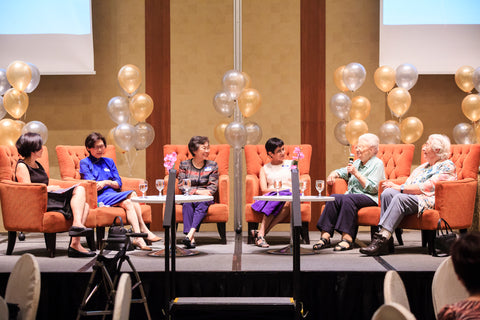
From left to right: Professor Esther Goh (Head of Department of Social Work), Professor Chan Heng Chee, Mrs Lee Wang Cheng Yeng, Dr Sudha Nair, Mrs Ann Wee and Mrs Jean Marshall. (Image credit: Lionel Lin)
The event also marked the pre-launch of her forthcoming NUS Press book, A Tiger Remembers: The Way We Were in Singapore.

(Image credit: Lionel Lin)
Born in the Year of the Fire Tiger, Mrs Wee moved to Singapore in 1950 to marry into a Singaporean Chinese family and was ushered into a world of cultural expectations and domestic rituals that she eventually came to love. Her work in Singapore’s fledging social welfare department that decade only deepened her cross-cultural learning and appreciation for the shapes and forms of the Singapore family. These experiences and “things that the history books left out” are affectionately observed and wittily narrated by Mrs Wee in her book.

Mr John Ang, Senior Fellow at the Department of Social Work, gave a preview of A Tiger Remembers. (Image credit: Lionel Lin)

Mrs Wee presented an autographed cover of A Tiger Remembers to Minister Tan. (Image credit: Lionel Lin)
The afternoon ended with Minister Tan presenting the Ann Wee NUS Social Work Alumni Award to three awardees, and a birthday cake-cutting ceremony.
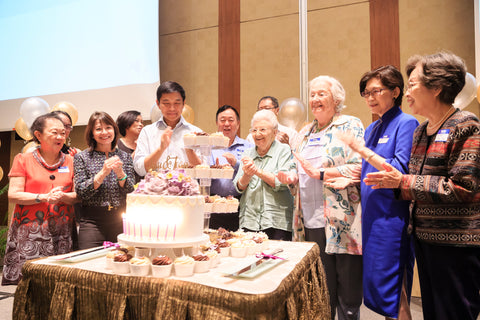
(Image credit: Lionel Lin)
A Tiger Remembers will be available in all good bookstores in October 2016. Mrs Wee will be donating her royalties to the Faculty of Arts and Social Sciences Student Advancement Scholarship Fund.
Book Launch of Walter Woon’s The ASEAN Charter: A Commentary November 19, 2015 14:31

from left: Former Foreign Affairs Minister George Yeo, Professor Walter Woon, Professor Tommy Koh, former Senior Minister S. Jayakumar, and NUS Press Director Peter Schoppert.
Professor Walter Woon’s The ASEAN Charter: A Commentary was launched on 13 November 2015 at the NUS Faculty of Law.
The ASEAN Charter comments on the provisions of the 2008 Association of Southeast Asian Nations (ASEAN) Charter, which established ASEAN’s legal status and institutional framework. Professor Woon, a Member of the High Level Task Force that drafted the Charter and Singapore’s former Attorney-General, crafts an insider’s perspective on the making of the Charter, elucidates how its provisions came to be drafted, and how they relate to diplomatic practice. As both former Foreign Affairs Minister George Yeo and Singapore’s Ambassador-at-Large Professor Tommy Koh eulogised during the launch, The ASEAN Charter is a very important and useful reference text for ASEAN officials and scholars, as well as members of the public who are interested in the organisation.
George Yeo on the “magic of ASEAN”
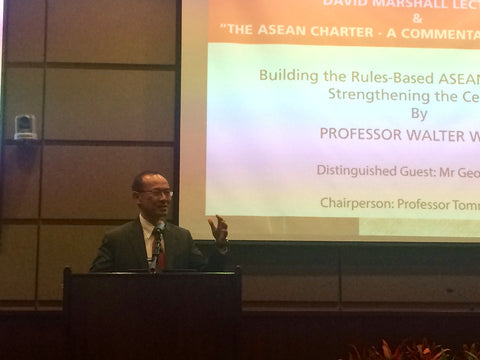
Graced by the likes of former Senior Minister S. Jayakumar as well as numerous members of the legal community, the launch of The ASEAN Charter commenced with a few words from George Yeo in praise of ASEAN. Highlighting Myanmar's National League for Democracy’s latest victory at the polls, Yeo attested that this outcome was in part a “triumph of ASEAN”. Indeed, such is the “magic of ASEAN”—a space that allows room for disagreement, evolution, and provides time for the branch to gradually bend, Yeo affirmed. Continuing in this positive vein, Yeo concluded that that despite criticisms, ASEAN has not only kept the peace in the region, but is also a historical necessity that will hold together with time.
ASEAN: Rolls-Royce ambition, Volkswagen model

Less sanguine about ASEAN was Professor Woon in his professorial lecture on the imperative to build a rules-based ASEAN community and strengthen the association’s centre.
Professor Woon stressed that ASEAN is “in essence not a legal institution”, having begun its life as a confidence-building mechanism for bickering countries and continued with an “ASEAN way” of being ad hoc. Accordingly, the formal rules that the ASEAN Charter intends to set in place do not sit well with ASEAN practice. Seen from this perspective then, ASEAN appears to have the “ambition to create a Rolls-Royce organisation, but fit[s] it with a Volkswagen model with dodgy software”. Professor Woon ultimately compared the Charter to a camel, being serviceable but inelegant.
What could upgrade ASEAN to become a full-fledged Rolls-Royce vehicle then? Professor Woon flagged a few areas that could be improved. Firstly, a proper legal service with international lawyers was needed to establish a rule-making centre that would also ensure the coherence of and compliance with such rules. Another aspect that a rules-based organisation requires is a proper dispute settlement system, with ASEAN’s current system being designed to be ineffective, Professor Woon lamented. The fact that the ASEAN High Council has never been convened was cited as evidence of such ineffectiveness. Moreover, the bringing of disputes to political settings like the ASEAN Summit—as has been done—is fatal to ASEAN’s credibility as a rules-based organisation. Ending on a more ambiguous note, Professor Woon pondered the possibility of being able to celebrate this rules-based element in time with ASEAN’s jubilee year in 2016.
A camel on shifting sands: Tommy Koh on ASEAN

Professor Tommy Koh was able to draw the book launch to a more buoyant close. Picking up on Professor Woon’s earlier camel metaphor for the ASEAN Charter, Professor Koh defended the association by extolling the importance of the animal to the audience’s amusement. To be sure, the camel might lack elegance, but in Professor Koh’s words, the anatomy of its hoofs, for instance, allows it to walk across shifting sands—likewise then for ASEAN, in its ambitions and efforts over the years.
The ASEAN Charter: A Commentary is now available at NUS Press.
Alfred Russell Wallace the “forgotten” hero: Why is Darwin more famous than Wallace? October 2, 2015 17:01
Ask the man on the street about natural selection, and you are bound to hear the name Charles Darwin. Indeed, it would be easy to conclude from this that Darwin is the de facto founder of natural selection as a concept. Yet, in recent years many have pointed to the concomitant, independent discovery of natural selection by Darwin’s contemporary, Alfred Russell Wallace, and lament the paltry amount of credit accorded to him.
Dr John van Wyhe, a historian of science at NUS and the editor of The Annotated Malay Archipelago, debunked this apparently “forgotten” reputation of Wallace as Darwin’s equal at a lecture given at the Singapore Science Centre on 26 September 2015. Dr van Wyhe’s Annotated Malay Archipelago is the first ever fully annotated version of Wallace’s classic account of his travels in Southeast Asia to appear in English, updating the original text with explanations, a bibliography of related material, and an in-depth introduction. Wallace’s The Malay Archipelago was an immediate success following its publication in 1869. Captivating generations of audiences with its descriptions of places and people, the book even inspired the likes of Joseph Conrad and David Attenborough.
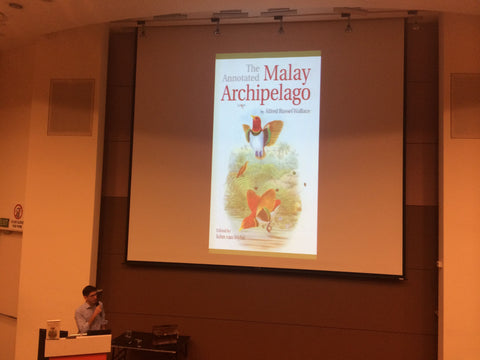
Wallace the “forgotten” hero: Why is Darwin more famous than Wallace?
Dr van Wyhe opened the lecture with the very question that many have recently posed in response to the independent discovery of natural selection by both Darwin and Wallace, namely – if this phenomenon was something that the pair had discovered (albeit separately), why is Darwin so much more famous than Wallace?
As an inquiry that began in the 1950s, this has since spiraled into claims – according to Dr van Wyhe – that Wallace was not only unjustly “forgotten” but also the “victim of a conspiracy”. Some have even put forward that Darwin had plagiarized Wallace’s work. In fact, the more books are written about Wallace, the more firmly his status as a “forgotten” hero seems to be cemented, Dr van Wyhe observed. Exaggerated statements thus abound about Wallace being “the greatest field biologist”, and even Black Books comedian Bill Bailey has exclaimed with injustice that natural selection “was known as a joint theory [by Darwin and Wallace] for decades!”
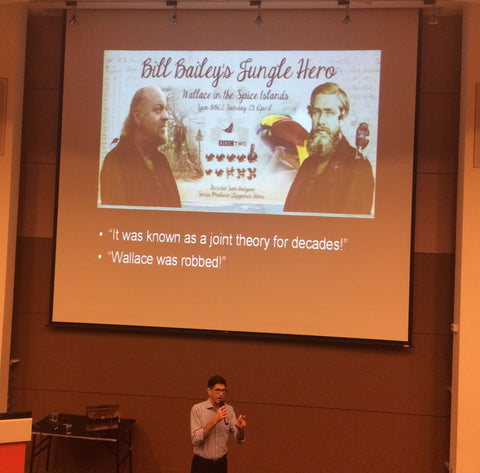
We might perceive Wallace to be unfairly left out of the limelight then, only because we have been told that this is so, Dr van Wyhe argued. Additionally, this “forgotten” descriptor of Wallace may perhaps have been arrived at with the false impression of Wallace’s relatively “humble background” that persuades one of his deserving better recognition. Wallace was certainly no peasant, having been sent to a school for gentlemen in his youth, for example.
The real, historical Wallace
If not a “forgotten” hero, who could the real Wallace be? After his school days and a voyage to the Amazon, Wallace arrived at Singapore in 1854, Dr van Wyhe delineated. It was here that Wallace made expeditions to Bukit Timah, trips which would form part of his material for The Malay Archipelago. Wallace’s influence as a naturalist still resounds among parts of the island today, with roads and nature trails named after him, for instance.
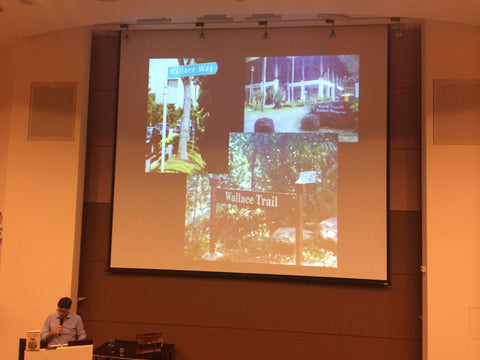
Southeast Asia was also where the idea of natural selection first came to Wallace in 1858. Penning down his thoughts on the subject, Wallace decided to first send these off to Darwin, who he felt would be sympathetic to ideas of such a nature. (These notions had previously also occurred to Darwin 20 years ago in 1838, though nothing had been published by him at that point.) Upon reception, the choice was made to have Darwin’s and Wallace’s ideas published together in a paper. However, very few took notice of this scholarship at that time.
With this piece of information, some might clamour again for the rightful recognition of Wallace’s role in discovering natural selection. Yet, more importantly, as Dr van Wyhe put it, the household recognition of only Darwin’s name today is quite simply because it was his book which had convinced people of the verity of natural selection. Wallace’s discovery notwithstanding, Darwin’s The Origin of Species still contained other numerous ideas that Wallace had never conceived of, a fact that the latter freely admitted to. Indeed, Wallace was even part of the flurry of voices commending Darwin’s unprecedented work at that time. Rounding things up, it may perhaps be more accurate then to view the Wallace-Darwin relationship as one filled not so much with animosity, but academic camaraderie, Dr van Wyhe concluded.
The Annotated Malay Archipelago is now available at NUS Press.
Book Launch of Clinical Psychology in Singapore September 22, 2015 13:41
Dr Gregor Lange and Dr John Davison’s book, Clinical Psychology in Singapore: An Asian Casebook, was launched at the Brahm Centre in Ren Ci Hospital, on 17 September 2015.
As an unprecedented look into clinical psychology and its practices in Singapore, the book offers case studies based on Singaporean clients, and sheds light on how psychologists deal with the different cultural and ethical issues encountered in their work here. These case studies encompass a range of mental health problems ranging from pyromania to depression, and span across age groups as well. Notably, the casebook came together with contributions from numerous members of Singapore's psychology community, many of them being present among that evening's audience of academics, practitioners, and members of the general public.
The launch was an occasion packed with as many laughs as there were moments of more sombre reflection – this perhaps being not unlike the ups and downs faced in engaging with clinical psychology in Singapore so far.
Q: What is the state of mental health in Singapore? A: Stateless
Dr Ong Lue Ping, IMH's Principal Clinical Psychologist, kicked off the event with his talk on the state of mental health in Singapore.
His pronouncement was – in Dr Ong’s own words – most “provocative”, for he went on to declare Singapore’s state of mental health as being, in fact, “stateless”. Though this was met with some amusement from the audience, Dr Ong lamented the real dilemma encountered in this. On one hand, psychologists in Singapore hospitals are still expected to “defer” to doctors and psychiatrists. Yet, on the other hand, independent psychologists working outside of this system are often simultaneously seen by the public as being “atas”. Undeterred by this, Dr Ong rounded things up by proposing three factors that had to be attended to equally in clinical psychology – namely accessibility, quality, and affordability – in order to rectify existing flaws in practice.
Merlion on the couch
A streak of joviality was picked up again in Dr Lange’s address. Regaling the audience with how he and Dr Davison had edited Clinical Psychology in Singapore together, Dr Lange sent people up in laughs by joking that one of the more exciting titles actually considered for the casebook was none other than Merlion on the Couch.
Such irreverent humour aside, Dr Lange also spoke about why he and Dr Davison decided to embark on such a book. While teaching psychology at NUS, it was a revelation for the both of them that case studies to be used always took place in the US or other parts of the West. This difference in setting – which could range from the usual Hollywood celebrity gone mad profile to the scenario of a cocaine-taking young adult in downtown LA, Dr Lange explained animatedly – was something that students here frequently could not relate to. Yet, there was a dearth of resources in the local context that could be utilized in class. The need for a casebook designed for Singapore thus arose.
Of paradoxes and paychecks
Next was an expert panel on the future of clinical psychology in Singapore, including Ms Jennifer Teoh, Director and Senior Principal Forensic Psychologist at MSF’s Clinical and Forensic Psychology branch, Dr Simon Collinson from NUS, and Mr Timothy Leo, Director of the Psychological & Correctional Rehabilitation division at Singapore Prison Service.
Intriguingly, Dr Davison asked the panel about a paradox that seems to play out in Singapore - that is, the fact that it is often difficult to involve the client’s family in therapy, despite how Singapore is ‘supposed’ to be a country rooted in collectivism. To this, Ms Teoh shared that the MSF started a functional family therapy scheme a year ago that would enable the whole family to be seen together outside of working hours, thus perhaps resolving the practical complications that contribute to this situation. Dr Collinson further suggested that there has to be an improvement in the training offered in family therapy, so as to better ease families into being engaged throughout the process.
Besides this, Mr Leo also remarked that the biggest challenge for psychologists in the next five years should concern the respect for psychology as a science. Making the timely observation that psychologists like Dr Daniel Chan were involved in the media as commentators on the recent elections here, Mr Leo commented that such screen time should be seen as good opportunities for the discipline, and more psychologists could follow suit to step up to the plate in terms of advocacy.
Finally, closing the discussion on a lighter note, Dr Davison fired a series of quick questions at the panelists, one of these being on whether psychologists in Singapore should be paid more. To which all three panelists chorused in unison: “Yes.”
Clinical Psychology in Singapore: An Asian Casebook is available at NUS Press and Kinokuniya Singapore Main Store. Clinical Psychology in Singapore is a unique resource on the practices and principles of clinical psychologists in Singapore. An ideal complement to abnormal, counselling or clinical psychology courses, it is the textbook for PL3236 Abnormal Psychology at the National University of Singapore and will be a supplementary text for Temasek Polytechnic’s Abnormal Psychology module by April 2016. Please email sebastian_song@nus.edu.sg for all enquiries on textbook adoption and review copies.
NUS Press attends 22nd Beijing International Book Fair August 25, 2015 15:12
NUS Press will be attending the upcoming Beijing International Book Fair from 26 to 30 August 2015. The Fair will be held at the China International Exhibition Center (Shunyi), featuring five exhibition halls with 66,000 square meters of exhibition space.
NUS Press will be part of the Singapore contingent, displaying our books at East Hall 2 (E2) Booth J20. Director of NUS Press, Peter Schoppert, will be attending the fair so do drop by our booth to find out more about NUS Press and to browse our selection.
Here’s a highlight of some titles:
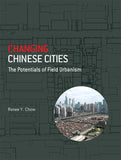 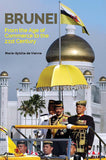 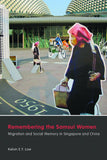 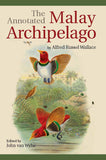  
|
- Changing Chinese Cities: The Potentials of Field Urbanism
- Brunei: From the Age of Commerce to the 21st Century
- Remembering the Samsui Women: Migration and Social Memory in Singapore and China
- The Annotated Malay Archipelago by Alfred Russel Wallace
- Community, Commons and Natural Resource Management in Asia
- State and Finance in the Philippines, 1898-1941: The Mismanagement of an American Colony
- Vietnamese Traditional Medicine: A Social History
We look forward to seeing you.
Conjuring Dublin and Singapore in Goh Poh Seng's work August 24, 2015 14:03
The Irish Ambassador Geoffrey Keating and his wife generously hosted a reception on 14 August 2015 to celebrate the publication of Singapore literary pioneer Goh Poh Seng’s Tall Tales and Misadventures of a Young Westernized Oriental Gentleman, a vivid and evocative memoir of the author’s time in Dublin as a student in the 1950s. The evening was convivial, and a testament to the power of words to make one hear, feel and see cities and persons anew.
Joined by guests from academia, the embassy, and government agencies, as well as publishers, writers and personal friends of Goh Poh Seng, a few words about his memoir were said by Ambassador Keating, NUS Press Director Peter Schoppert, NTU Professor Koh Tai Ann, and Northern Irish-Canadian writer George McWhirter through Irish editor and writer Rosemary Lim.
Worlds Within World
“I loved the book”, his Excellency stated plainly. “To me, as a Dubliner, it is extremely and deeply evocative. And even though the city Dublin has changed so much over the past 60 years, the city he describes is almost instantly familiar and recognizable.”

Goh, he mused, was lucky to have made his way into the artistic and literary circles of 1950s Dublin. Indeed, one of the central stories in Tall Tales is an intense discussion with Irish poet Patrick Kavanagh over what it means to be a poet. His Excellency suggested a literary pilgrimage to the UNESCO City of Literature, enticing us to see the traces of Wilde, Beckett, and Shaw, as well as walk the paths of Joyce’s Stephan Dedalus and Leopold Bloom. In fact, Dublin prides itself on having produced the most Nobel Prizes for Literature than other city in the world.
The Reinvented Man
Next was Professor Koh Tai Ann, who was also a personal friend of Goh’s and was one of the persons responsible for the republication of Goh’s first novel with NUS Press. She regaled the audience with the insider information about its publication – and its rejection by Paul Theroux’s publisher for being “too local” – and other aspects of his life, such as the poetry slams and supper club at his establishment Rainbow Lounge, and his foresight with building conservation and tourism. But Prof Koh also pointed out that his idealism and pluck was accompanied by an overreaching and a lack of business sense.

Highlighting that the memoir was titled “Tall Tales”, she wondered about which parts were fact and which fiction. Nonetheless, Goh’s first poem was written in Ireland and the form of Goh’s first novel If We Dream Too Long had parallels to Joyce’s The Portrait of the Artist as a Young Man: as Joyce’s characters trek through Dublin, Goh’s tracks 1960s Singapore from Changi to Chinatown, to Esplanade and Tanglin Club, capturing in print both the physical landscape of the time and, through the stream of consciousness, its zeitgeist.
A Star-Lovely Art
Northern Irish-Canadian writer, and Vancouver’s first Poet Laureate, George McWhirter’s reflections on the publication were read out by Rosemary Lim, an Irish writer and editor who also also conducts literary tours of Singapore.

Like his Excellency, McWhirter enjoyed the way Goh brought Dublin to life, “Like Heinrich Böll’s Irish Journal, Goh Poh Seng’s book lets me see Ireland with other eyes and feelings for my native land that are intimate and ironical, loving and leery, spliced from something very Celtic and Chinese in the braided history that brings Poh Seng and binds him to the island. The book also has his very own way of looking, his young bucko’s oriental, will o’ the wisp in the eye. Full of cheeky curiosity, he loves theatre and goings-on, and is blessed to find himself in a city where every room and street is a stage, and there’s always something going-on. ”
Drawing the event to a close, his Excellency thanked all present and announced that dinner was served, along with free-flow Guinness, and – to hearty cheers – whisky from both parts of Ireland! Certainly an apt way to affirm that home can come to us in more ways than one.
Thanks
NUS Press would like to thank Ambassador Geoffrey Keating, his wife and the Embassy of Ireland, for their hospitality; Neil Murphy for making the connection; and Koh Tai Ann, George McWhirter and Rosemary Lim.
Notes
Goh intended to write a three-volume memoir, but unfortunately passed away before he could complete it. Margaret Goh, the wife and literary executor of Goh's estate – and once director of Singapore University Press, the former NUS Press – passed away in 2014. Their children now manage the estate.
Tall Tales and Misadventures of a Westernized Oriental Gentlemen and If We Dream Too Long are available at NUS Press.
Philip Taylor wins 2015 Nikkei EuroSEAS Social Science Book Prize: Five NUS Press titles shortlisted August 19, 2015 16:40
We are pleased to announce that Philip Taylor has won the inaugural Nikkei EuroSEAS Social Science Book Prize awarded by the European Association for Southeast Asian Studies at a reception at the University of Vienna on 12 August 2015.
The Social Science Prize was awarded to Taylor for his The Khmer Lands of Vietnam: Environment, Cosmology and Sovereignty. "In this meticulous, absorbing and often poignant book, Philip Taylor draws on years of fieldwork to take us among the appealing, resilient and ecologically gifted Khmer speaking minority in southern Vietnam. This is the first book in any language to treat these beleaguered men, and women with the sustained, sympathetic attention that they deserve." - David Chandler

The prize was accepted on behalf of the author by Gerald Jackson, of NIAS Press, which co-published the European edition of the book. (You can just make him out in the photo at left...)
Khmer Lands was just one of five books originated by NUS Press which made the EuroSEAS shortlist, in both the social sciences and the humanities categories. We are greatly honoured by the nominations and would like to thank everyone for their continual support. The additional shortlisted titles are mentioned below:
Shortlisted for the Humanities Book Prize
 Surabaya, 1945-2010: Neighbourhood, state and economy in Indonesia’s city of struggle by Robbie Peters
Surabaya, 1945-2010: Neighbourhood, state and economy in Indonesia’s city of struggle by Robbie Peters
"This is a brilliant book, a must read for anybody wanting to understand the Asian city...Peters has written what I believe is the best study of any Indonesian kampung. Few scholars have managed to do such close and complex ethnographic and oral history research - gaining the trust of people from the lowest to the highest levels of a seemingly chaotic urban society." - Lea Jellinek
 Squatters into Citizens: the 1961 Bukit Ho Swee fire and the making of modern Singapore by Loh Kah Seng
Squatters into Citizens: the 1961 Bukit Ho Swee fire and the making of modern Singapore by Loh Kah Seng
"This excellent book - located at the intersection of history, ethnography and sociology - makes a major contribution to our understanding of the social history of post-war/post-colonial Singapore, and more generally to the interdisciplinary field of disaster studies." - James Francis Warren
Shortlisted for the Social Science Book Prize
 Mobilizing Gay Singapore: rights and resistance in an authoritarian state by Lynette J. Chua
Mobilizing Gay Singapore: rights and resistance in an authoritarian state by Lynette J. Chua
"Mobilizing Gay Singapore fills a void in foreigners’ understanding of gay issues in Singapore. It will remain for some time the standard work on the subject and is a very welcome addition to the LGBT canon."
- Nigel Collett
 Fields of Desire: poverty and policy in Laos by Holly High
Fields of Desire: poverty and policy in Laos by Holly High
"In this beautifully composed ethnography on poverty reduction programs in Laos, Holly High uncovers the ambivalence with which rural people regard state power. Her meditation on the ambiguity of desire in state-society relations is path-breaking and offers new insights into the nature of rural citizenship in Southeast Asia and beyond." - Philip Taylor
We are greatly honoured by the nominations and would like to thank everyone for their continual support.
Of Whales and Dinosaurs book talk with author Kevin Tan June 3, 2015 16:00
NUS Press held a book talk at the Lee Kong Chian Natural History Museum on 29 May 2015. Dr Kevin Tan, author of Of Whales and Dinosaurs: Singapore’s Natural History Museum, was present to give a talk about the museum's natural history collection.
Full house at NUS Press book event with Dr Kevin Tan
In his talk titled “Singapore’s Natural History Collection: A Perilous Prologue”, Dr Tan took the audience through the long and perilous 127-year history of the Raffles Zoological Reference Collection. He shared anecdotes of the brave individuals and past curators who managed to keep the collection mostly intact through two world wars, numerous financial and leadership crises, and the damning hand of modernisation and progress after Singapore’s independence.
Notably in 1942 when Singapore was occupied by Japan during World War II, the fate of its cultural heritage and natural history collections was uncertain. After Singapore’s surrender, E. J. H. Corner, the assistant director of the Botanic Gardens, had a “crazy idea” to “approach the Japanese to preserve the [collections]”. Dr Tan recounted how Corner approached the Japanese authorities with a note signed by the Governor to request them to protect the cultural properties.
Corner was joined by Hidezo Tanakadate, a professor from the University of Japan, who proclaimed that he had come to “conserve the cultural heritage”. Many years later it was discovered by Corner that Tanakadate had no real military authority to take over Singapore’s cultural heritage; he only had the rank of a sublieutenant. Dr Tan emphasised that it took the courage of such individuals who recognised the importance of the natural history collection and endeavoured to preserve it. The dedication and efforts of these stalwarts are duly recorded in Of Whales and Dinosaurs.
Mrs Yang Chang Man, former curator of the natural history collection, was also present at the book event to show her support. Mrs Yang and her team kept the collection from disintegration in the early 1970s when the government’s nation-building focus marginalised natural history and placed priorities elsewhere.

Dr Tan and Mrs Yang (both in pink) with the NUS Press team
During the Q&A session, Dr Tan took a question from an audience who asked about the legal protection for cultural heritage.
"I’m afraid there’s no real legal protection [in Singapore] but the [natural history] collection does belong to [National University of Singapore] now. I’m quite sure the university has insured the collection and I think it’s probably in the safest hand possible.”
Another audience posed the question on the possibility of retrieving the whale skeleton which was given to the National Museum in Kuala Lumpur in 1974. Dr Tan shared the possible legal and diplomatic complications in recovering the mounted whale skeleton:
“It’s not a problem of money if the [skeleton] is for sale because it is a matter of national pride. But it’s not so direct [to retrieve it back]…since the skeleton was given to the federal government, not to the state government.”
Dr Tan addressed the last question on the damage incurred by the collection before Lee Kong Chian Natural History Museum was established and the possibility of expansion for the new museum.
“Very little [of the collection] was actually lost, thanks to Mrs Yang [Chang Man] and her team. Specimens do deteriorate over time so you have to throw [them] away. That’s [inevitable] given our weather and the [poor storage conditions]...The museum did lose two of the biggest things: the whale skeleton (given to Malaysia) and the skeleton of the elephant which was shot by the Sultan of Johore in 1909.
...I’m sure there’s room for expansion. In fact the museum never ceases to grow. Many of the specimens here are post-1970s. The museum scientists continue to go on expeditions. In terms of biodiversity the sea life is richer and much more unexplored [in Singapore]...For instance the fish collection has grown a lot. Peter Ng, director of the museum, is also one of the leading experts in crabs so the crab collection is amazing.”
Thank you for your support for Of Whales and Dinosaurs. Do visit the Lee Kong Chian Natural History Museum to learn more about Singapore’s rich biodiversity and natural history.
Portrait of the artist as a young man April 27, 2015 13:30
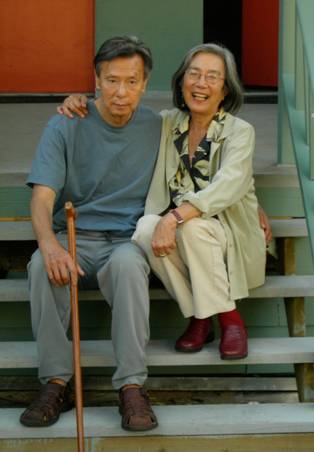
Goh Poh Seng with his wife, Margaret, on the front steps of their home in Vancouver. Image courtesy of the Estate of Goh Poh Seng. |
The Business Times' write-up on Tall Tales and Misadventures of a Young Westernized Oriental Gentleman:
GOH POH SENG was a literary pioneer. He wrote Singapore's first novel If We Dream Too Long (1972) which depicts the hopes and frustrations of young people in the newly independent country.
He also wrote the 1966 play about family life titled When Smiles Are Done, which represents an early attempt to capture Singlish on stage. To do that, he spent a year and a half "hanging around public places with a tape recorder and listening to how people spoke".
Goh died in 2010 at the age of 73. But even though he was diagnosed with Parkinson's disease in 1995, he continued to write short stories, a number of which appear in this new book published posthumously by Ridge Books of NUS Press.
Tall Tales and Misadventures of a Young Westernized Oriental Gentleman is a collection of stories about his student days in 1950s Ireland where he had been sent at the age of 16 by his Malaysian family to study towards becoming a doctor.
It appears that it was in Ireland that Goh truly came of age. Bright, curious and cocky (he refers to himself as a "sexy fellow"), he led a bohemian lifestyle despite having earlier converted to Catholicism "on account of acute loneliness and homesickness".
Our author Loh Kah Seng on the history of public housing in Singapore April 22, 2015 09:00

NUS Press author Loh Kah Seng weighs in on Singapore's public housing policy and why it might not be advisable as a model for Taiwan over at Thinking Taiwan.
Via Thinking Taiwan:
"Most Singaporean commentaries on public housing show a limited grasp of history. In the standard account, the pre-history is a caricature of insanitary slums and squatter areas. The 'housing crisis' is, then, vanquished by the HDB's success in building low-cost housing for the people. This narrative ignores, however, the larger historical context.
Public housing did not begin with the PAP but was shaped by global developments. The HDB's efforts drew upon ideas of state-planned housing from Britain and the U.S. after the Second World War. To the Western powers, state intervention in housing was crucial to make developing countries safe for decolonization and from communist subversion. The PAP's 1963 slogan of an all-out assault on the five 'ogres' of a 'subservient society' — poverty, disease, ignorance, squalor, and idleness — was lifted out of the pages of the foundational document of the British welfare state, the 1942 Beveridge Report. As the language of squalor made housing an arm of the state, so where one lived became a matter of national policy."
Pair this article with Loh's book Squatters into Citizens: The 1961 Bukit Ho Swee Fire and the Making of Modern Singapore, which argues that the fire was a catalyst for Singapore's emergence as a modern state.
Lee Kong Chian Natural History Museum opens; Of Whales and Dinosaurs on its history April 20, 2015 09:00
The Lee Kong Chian Natural History Museum was officially opened by Dr Tony Tan, Singapore President and Chancellor of NUS, on 18 April 2015. Over 250 guests attended the official opening to commemorate this significant occasion for Singapore's first and only natural history museum.

Dr Tan was presented with the book Of Whales and Dinosaurs: The Story of Singapore’s Natural History Museum written by Kevin Y. L. Tan. Of Whales and Dinosaurs traces how the Lee Kong Chian Natural History Museum came into being. It recounts the 127-year history of the natural history collection that now forms the core of the new museum. The book highlights the dedication and efforts of the stalwarts who overcame the odds to protect Singapore's natural history heritage.
Of Whales and Dinosaurs retails at NUS Press for $46. It is also available at leading bookshops in Singapore.
Goh’s last work, Tall Tales and MisAdventures of a Young Westernized Oriental Gentleman, provides intimate insights into his formative years April 14, 2015 10:00

In the upcoming Tall Tales and MisAdventures of a Young Westernized Oriental Gentleman, Singapore’s English-language literary pioneer Goh Poh Seng records the trials and tribulations of his first steps as a poet. As an impressionable young medical student in the Ireland of the 1950s, Goh struggled between his family’s expectations that he should become a doctor and his passion for writing. While it concerns his early writing career, Tall Tales was composed in Goh’s last years, and it shows in the fluency of his mature style. The book forms a poignant finale to Goh’s literary legacy – he passed away in 2010, from complications due to Parkinson’s disease, while working on the memoir.
The memoir tells one of the common stories of the 20th century – the young colonial sent to the metropole for an advanced education – but in this case in the words of an uncommon young talent, whose ambitions for his own education went far beyond attending medical school. The nine chapters chart the awakening of Goh’s love of words and provide insights into his self-discovery. The book also reveals the extraordinary characters that shaped Goh’s literary journey. In particular he was deeply influenced by the Irish poet Patrick Kavanagh and the Irish novelist and playwright Samuel Beckett. Memorable encounters with these writers are recorded in the chapters “A Star-Lovely Art” and “Do I Dare to Eat a Peach?”.
Tall Tales is available through NUS Press’s Ridge Books imprint. It retails for S$25.68 including GST at Books Kinokuniya and leading bookshops in Singapore. Goh’s first novel If We Dream Too Long is also available at NUS Press.
In support of local literature, NUS Press is proud to present Tall Tales at The London Book Fair 2015 from 14 to 16 April.

